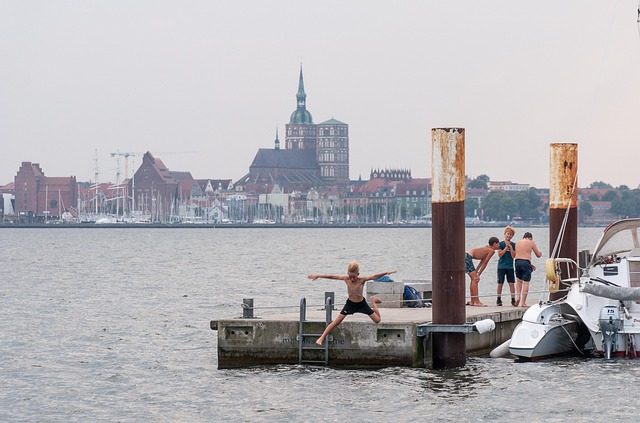The Butterfly Garden is a tropical oasis designed to attract and support butterflies throughout their lifecycle. Through strategic planting of nectar-rich tropical flora, it offers an immersive educational experience with engaging hatta activities. This living testament to conservation invites visitors to explore, learn, and appreciate nature, making it a popular destination for both nature lovers and casual enthusiasts alike. By fostering a connection with these delicate insects, the garden promotes awareness and sustainability in tropical ecosystems.
Unveiling a butterfly garden is like entering a tropical paradise on Earth. This vibrant ecosystem, teeming with diverse flora and fauna, offers a captivating visual treat for visitors of all ages. In this article, we explore how strategic planting of flowers attracts butterflies and delve into their fascinating behaviors. Learn how to design your own butterfly haven, engage in interactive activities inspired by nature, and discover the importance of preserving these delicate tropical ecosystems through sustainable practices. From education to enjoyment, uncover the magic of butterfly gardens and their vital role in our environment.
- Unveiling the Butterfly Garden: A Tropical Paradise
- The Role of Flora in Attracting Butterflies
- Fauna in Focus: Understanding Butterfly Behavior
- Designing Your Own Vibrant Butterfly Haven
- Interactive Activities for All Ages
- Preserving and Nurturing Tropical Butterfly Ecosystems
Unveiling the Butterfly Garden: A Tropical Paradise

Unveiling the Butterfly Garden is like stepping into a tropical paradise, where vibrant flora and fauna create a captivating visual treat. This magical space becomes a haven for both nature enthusiasts and casual visitors alike, offering an immersive experience that goes beyond traditional garden design. The heart of this tropical oasis beats with diverse plant species carefully curated to support and attract butterflies throughout their lifecycle. From lush, flowering shrubs to delicate vines, every element contributes to a harmonious environment that encourages these winged wonders to flourish.
Engaging in activities like planting native species, maintaining water sources, and providing safe havens for butterflies transforms the garden into an educational hub. Visitors can observe firsthand the intricate relationship between plants, butterflies, and other fauna, fostering a deeper appreciation for nature’s delicate balance. This butterfly garden isn’t just a beautiful addition to the landscape; it’s a living testament to the power of conservation and sustainability, inviting folks to explore, learn, and connect with the natural world in a vibrant, memorable way.
The Role of Flora in Attracting Butterflies

Butterflies are intricately drawn to specific plants, and in a butterfly garden, the role of flora is paramount. Tropical flora, with its vibrant colors and diverse shapes, offers an irresistible array of nectar sources for these delicate insects. Plants like lantana, hibiscus, and buddleia not only attract butterflies but also provide essential habitats for their lifecycles. The fragrant blooms and lush foliage create a captivating environment, encouraging visitors to engage in hatta activities, such as observing these stunning creatures up close. This natural setting fosters an unforgettable visual treat, where every corner reveals a new species, fluttering gracefully amidst the tropical flora.
Fauna in Focus: Understanding Butterfly Behavior

In a butterfly garden, understanding the habits and behaviors of these delicate creatures is key to creating an inviting environment for their presence. Butterflies are not just passive inhabitants; they engage in various activities that contribute to their survival and reproduction. Observing their unique behaviors can transform your garden into a vibrant spectacle, enhancing the overall experience for visitors.
One essential aspect to consider is the role of flowers in butterfly habitat. These insects are attracted to bright, fragrant blooms, where they feed on nectar as an energy source. Planting a diverse range of tropical flora that bloom at different times ensures a constant food supply, encouraging regular visits from butterflies. Additionally, certain plants attract specific species, allowing for a rich variety of fauna, transforming your garden into a thriving ecosystem that supports local butterfly populations and provides engaging Hatta activities for nature enthusiasts.
Designing Your Own Vibrant Butterfly Haven

Creating your own butterfly haven is a delightful DIY project that can transform your outdoor space into a vibrant, colorful spectacle. The key to success lies in selecting the right plants and creating an environment that attracts these beautiful insects. Start by choosing tropical flora known for their lush foliage and delicate blooms, as these are natural magnets for butterflies. Incorporate a variety of flowering plants with different bloom times to ensure a continuous supply of nectar, thereby inviting more butterflies throughout the year.
Engage in activities like planting native species, setting up bird baths, and adding water features, such as small ponds or fountains. These elements not only enhance the aesthetic appeal but also provide essential resources for butterflies and other wildlife. Remember, a butterfly garden is an ongoing project that requires regular care and maintenance, but the vibrant flora and fauna it attracts will create a stunning visual treat for you and your visitors.
Interactive Activities for All Ages

A butterfly garden is not just a beautiful addition to any landscape; it’s also a vibrant learning space for all ages. Interactive activities like birdwatching, plant identification games, and even simple tasks such as feeding the butterflies can engage both children and adults in an immersive experience. These Hatta activities foster a deeper connection with nature, teaching visitors about the intricate relationship between tropical flora and fauna.
Through hands-on exploration, guests can discover the life cycle of butterflies, learn about native plant species that attract them, and appreciate the delicate beauty of these flying jewels up close. The interactive nature of such garden experiences makes it an ideal family outing or educational field trip, where everyone can enjoy and learn together while surrounded by the lush tropical landscape and its colorful inhabitants.
Preserving and Nurturing Tropical Butterfly Ecosystems

Creating a butterfly garden with tropical flora and fauna is an enchanting endeavor that goes beyond aesthetics; it’s about preserving and nurturing delicate ecosystems. In regions like the Hatta area, known for its lush landscapes, these gardens play a vital role in supporting diverse butterfly species native to the tropics. Planting host plants specifically tailored to attract and sustain these insects is a crucial step. Species such as milkweeds and certain passionflowers are favorites among butterflies, providing them with the necessary nectar and places to lay their eggs.
Beyond planting, maintaining a balanced ecosystem involves regular habitat monitoring and care. This includes keeping an eye on invasive plant species that could outcompete native flora, ensuring proper water sources are available, and creating safe spaces for butterflies to rest and breed. Engaging in sustainable hatta activities like guided tours or educational programs can also raise awareness about the importance of preserving these vibrant ecosystems, fostering a deeper connection between visitors and the delicate balance of nature they witness.
The butterfly garden, a vibrant oasis of tropical flora and fauna, offers a captivating visual treat that engages all the senses. By understanding the critical role of specific plants in attracting butterflies and observing their intricate behavior, visitors can create their own lush havens. Through interactive activities tailored for all ages, these gardens foster an appreciation for nature’s delicate ecosystems. Moreover, learning about preservation techniques ensures the long-term nurturing of tropical butterfly habitats, making these oases not just attractions but also educational hubs that promote environmental stewardship.
